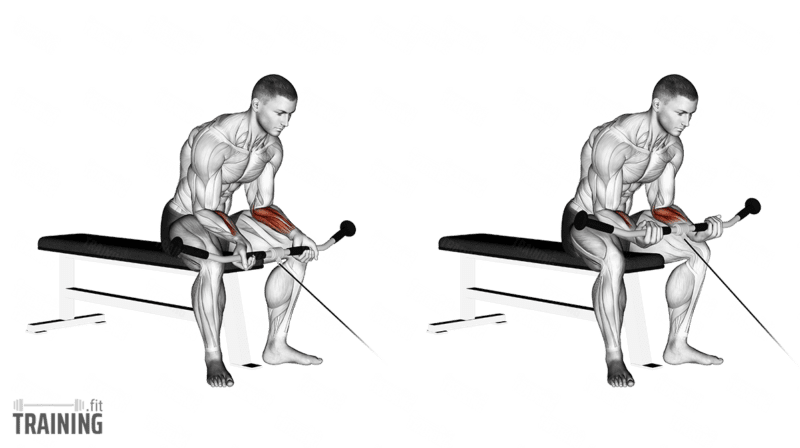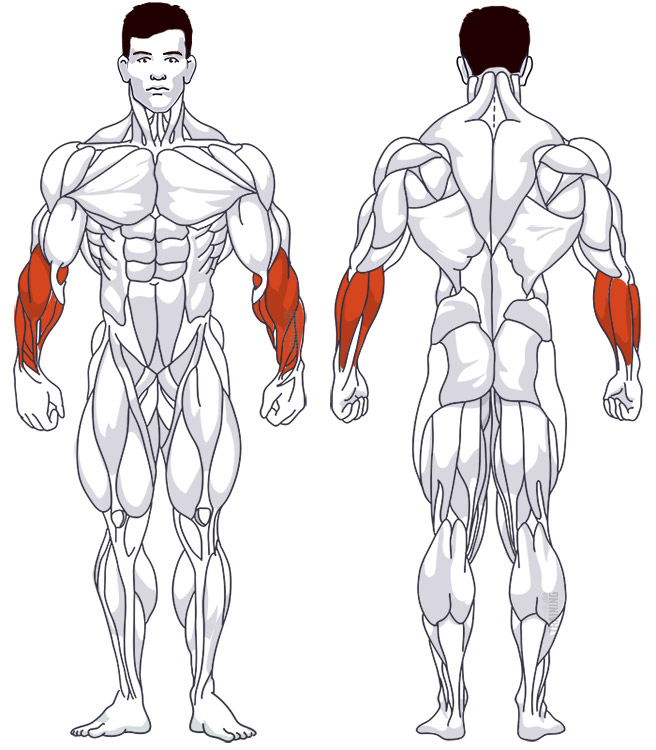Cable Wrist Curls
Isolation exercise, Cable pullOverview

Main muscles
- Forearm: Finger extensor
(Musculus extensor digitorum) - Forearm: Short radial hand extensor
(Musculus extensor carpi radialis brevis) - Forearm: Long radial hand extensor
(Musculus extensor carpi radialis longus) - Forearm: Brachioradialis
(Musculus brachioradialis)
Training plans
Cable Wrist Curls is a suitable substitute for similar exercises in or as a supplement to various training plans.
Cable Wrist Curls: Basics and alternatives

Involved main muscle groups:
Cable Wrist Curls
Cable Wrist Curls are a fantastic exercise for not only strengthening your forearms but also your fingers and wrists. That’s why it’s often called “wrist curls.” Training with the cable machine is pretty much the same as other forearm curls: just hold the triceps grip (preferably underhand) and lift and lower the weight by moving your wrists.
Though you might not see it often, cable wrist curls are super effective, mainly because the constant tension on the cable adds more stress throughout the exercise.
Other options include Dumbbell Wrist Curls, Barbell Wrist Curls, or even Barbell Wrist Curls behind the back. For home workouts, Fitness Band Wrist Curls are a great choice.
Correct execution
You can do cable wrist curls with either an overhand or underhand grip. Both variations help give your forearms a good workout.
Using the underhand grip lets you roll the handle further down your fingers, adding in the movement of finger curls and increasing the range of motion.
However, if you want to focus on your forearms, it’s best to include both grip variations in your routine. The underhand grip targets the flexors (benders), while the overhand grip works the extensors (stretchers). Ideally, you should find a balance and also incorporate an overhand grip forearm exercise into your workout plan.
Video tutorial
Step-by-step instructions
Position the weight bench lengthwise in front of the cable machine. Attach the triceps grip to the lower cable attachment.
Sit upright at the front end of the weight bench, directly in front of the cable machine. Your thighs should be as parallel to the floor as possible. If needed, raise your heels or place them on the bench’s feet to align your thighs parallel to the floor (see video).
Hold the handle with an underhand grip using both hands.
Place your forearms, still holding the triceps grip with an underhand grip, on your thighs. This will already lift the weight off the block. Push your wrists forward so they’re right above your knees.
Slowly lower the handle by extending your wrists downward. At the end of the stretching movement, gently open your hand, but keep your fingers bent at the end. This moves the handle to your fingers’ middle knuckles. You’re now in the starting position.
Pull the handle up by closing your fist. At the same time, bend your wrist and keep moving the weight up. Hold this position for a moment, and then slowly and smoothly lower the weight back down to the starting position.
Common mistakes and injuries
Like all forearm curl exercises, it’s crucial to perform the movement cleanly and with control. If you move the weight too quickly, you’ll stress your wrists and risk wrist injuries – which is what you’re trying to avoid with forearm and wrist training.
The weight movement should come solely from your wrists and hands. Avoid moving your forearms during the exercise. Your elbows should stay stationary throughout the entire exercise.
Additionally, be mindful of the amount of weight you’re using. Starting with too much weight can lead to poor form and increase the risk of injury. Begin with a lighter weight and focus on proper technique. As you become more comfortable with the exercise and your strength improves, you can gradually increase the weight.
Pay attention to any pain or discomfort in your wrists during the exercise. If you experience pain, stop the exercise and consult with a fitness professional or healthcare provider to address any potential issues.
Lastly, remember to warm up your wrists and forearms before performing cable wrist curls. Stretching and warming up can help prevent injuries and improve your overall performance during the exercise.